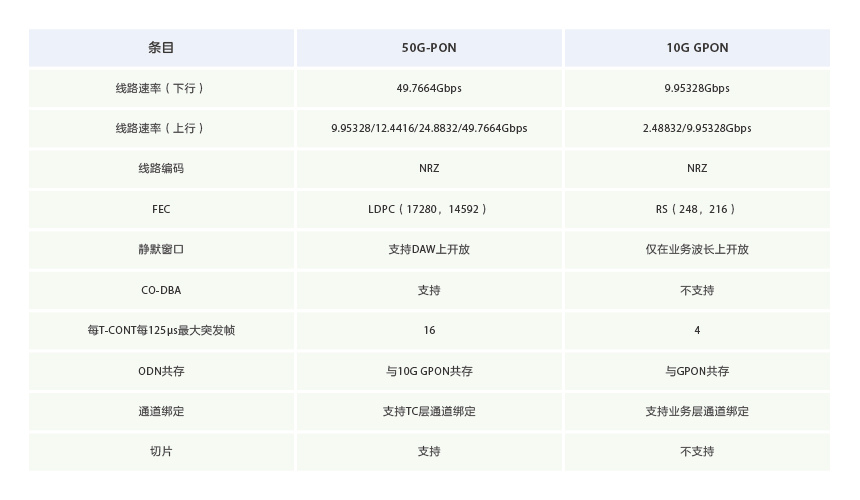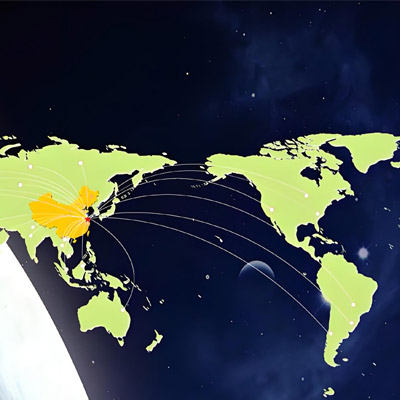50G-PON: The next generation of PON technology after 10G PON
Review of PON technology development
PON technology is a broadband access technology based on passive ODN networks. It adopts P2MP point-to-multi-point topology, with independent upstream and downstream transmission wavelengths, and data time-division multiplexing. The ODN network connecting OLT and ONUs in the PON system uses pure optical media, is passive throughout the process, is highly adaptable to the environment, and is easy to expand and upgrade. In the past 10 years, due to its comparative advantages over copper wire access in fiber-based, passive, P2MP, etc., PON technology has achieved great success and has been deployed on a large scale.
In the development of PON technology, standards organizations ITU-T/FSAN and IEEE have played a huge role in promoting it. PON technology originated from the early APON/BPON. After multiple generations of development, GPON and EPON have been deployed commercially on a large scale, providing users with bandwidth access capabilities of up to 100 megabytes. Its next-generation 10G PON technologies such as 10G GPON and 10G-EPON have also been commercialized on a large scale, providing users with bandwidth of up to 1Gbps, achieving gigabit network coverage, and meeting the large-scale application of 4K/8K video services, and Early import needs of VR/AR services.
As video services have become the basic business of broadband networks, and PON technology has gradually expanded from the home wide field to the government and enterprise industries, such as telemedicine, industrial intelligent manufacturing, factory and mining communications, etc., on the one hand, higher requirements have been put forward for bandwidth. On the other hand, corresponding requirements have also been put forward for latency, packet loss, jitter, service quality and user experience. For example, VR services have bandwidth requirements of more than 1Gbps, and user experience improvement requires a low latency of 5ms (RTT latency). In telemedicine, end-to-end communication latency is less than 50ms and jitter is less than 200μs.
In order to meet the business development needs of the post-10G PON era, IEEE and ITU-T/FSAN began to consider technical research work on the next generation of PON after completing the formulation of standards for 10G PON.
Next generation PON mainstream technology direction: 50G-PON
The industry generally recognizes that the bandwidth of the next generation optical access network will be increased to 50Gbps, so how to simply and efficiently upgrade system bandwidth has become a hot topic in the field of PON. The development trend of next-generation PON technology after 10G PON mainly has two directions: one is to increase the single wavelength rate; the other is to increase the total rate through multi-wavelength multiplexing.
IEEE took the lead in initiating the formulation of standards for next-generation PON technology after 10G PON. It supports 25Gbps downlink rate on a single optical fiber, supports 10Gbps/25Gbps uplink rate, and supports compatibility with 10G-EPON. For the 50Gbps bandwidth requirement, multi-wavelength superposition technology and channel binding technology are used to provide two 25Gbps channels to achieve a 50Gbps rate.
ITU-T/FSAN considers scenarios such as home users, enterprise users, and mobile backhaul/pre-delivery, and gradually forms a demand for the next generation of PON, focusing on 50G-PON technology with a single-channel rate of 50Gbps. In 2018, ITU-T/FSAN launched the formulation of a standard based on a single wavelength 50G-PON, named it "G.HSP (G.Higher Speed PON)". The standard is expected to be released in the second half of this year and is expected to be available in 2025. Commercial capabilities (see Figure 1). Before this point in time, 10G PON will be deployed for large-scale commercial use as the mainstream optical access technology in the industry.

Figure 1 Progress of the 50G-PON standard
The requirements of 50G-PON include providing more than 4 times access bandwidth compared to 10G PON, better service support capabilities, network protection/security, and supporting coexistence and smooth evolution of 10G PON, and being compatible with existing ODN networks as much as possible.
The upstream and downstream wavelengths of 50G-PON work in the O band and do not support simultaneous coexistence with GPON and 10G GPON. FEC uses LDPC error correction algorithm. In order to better support low latency, 50G-PON technology introduces technologies such as dedicated activation wavelength (DAW) and CoDBA (collaborative DBA). Using DAW technology, ONUs register and activate through dedicated wavelengths, and service wavelengths are no longer allocated silence windows, which can reduce the transmission delay caused by registration windowing. Using CoDBA technology, data is forwarded directly without waiting, which can reduce the latency caused by bandwidth scheduling.
The performance comparison of key functions of 50G-PON and 10G GPON technologies is shown in Table 1.
Table 1 Comparison of key performance between 50G-PON and 10G GPON

Evolution and coexistence of 10G GPON technology to 50G-PON
In the evolution of the network, it has always been the focus of operators to make full use of existing network resources and save upgrade and evolution costs. In order to realize the smooth evolution of 10G GPON to 50G-PON and meet the networking needs of different services, 10G GPON and 50G-PON will coexist for a certain period of time. In order to save room deployment space, reduce energy consumption of optical access equipment, effectively utilize the ODN resources of the existing network and reduce the network construction costs of operators, the use of multi-standard coexistence optical transceiver integrated module for office equipment is the most effective method that has been verified., such as adopting the Combo PON concept to achieve the combined wave of 50G-PON and 10G GPON.
For the coexistence of 10G GPON technology and 50G-PON technology, certain requirements need to be met:
- Support the coexistence of 10G GPON and 50G-PON technologies on the same optical fiber;
- Unupgraded ONU service interruptions should be avoided or minimized;
50G-PON supports and is compatible with 10G GPON services.
After many discussions, the ITU-T standards organization has made it clear that 50G-PON will not coexist with GPON and 10G GPON at the same time. Therefore, in the process of evolving to 50G-PON, a two-step migration approach can be considered for technical coexistence, first evolving from GPON to 10G GPON, and then evolving from 10G GPON to 50G-PON, while taking into account network evolution and cost. Continuous upgrade of bandwidth.
Analysis of key technologies of 50G-PON
50G-PON adopts single-fiber bidirectional transmission, downlink TDM time division multiplexing, and uplink TDMA time division multiple access to realize point-to-multipoint communication between OLT and ONU. Its key technologies include wavelength selection, line coding, line rate, FEC error correction technology, Common TC technology, PHY layer devices, etc.
- wavelength selective
50G-PON currently only has a small band of available wavelengths in the O band, which is not enough for 50G-PON systems. After many discussions, ITU-T has made it clear that 50G-PON will not coexist with GPON and 10G GPON at the same time. Some wavelength selections have been determined and some are still under detailed discussion.
- line coding
In the early discussion of ITU-T, various line codes such as PAM4, duobinary and NRZ were considered; due to the high optical power budget requirements of the PON system, the NRZ code with the best receiving performance was finally selected.
- line rate
ITU-T has clarified the rate requirements for 50G-PON and supports different combinations of symmetric and asymmetric rates; there is 1 downlink rate, and there are 4 line rates for the uplink rate.
- FEC error correction technology
After the 50G-PON line rate increases, receiver sensitivity decreases, and transceiver performance needs to be improved to reuse the ODN network that has been deployed in large numbers. In order to reduce the requirements for high-speed optical devices, 50G-PON introduces an LDPC (Low Density Parity Check) codec scheme for forward error correction of FEC.
- Common TC technology
50G-PON mainly achieves low latency through methods such as dedicated activation wavelength (DAW), CoDBA and reducing allocation periods.
The dedicated activation wavelength for DAW: It can be a newly defined wavelength or a PON system wavelength deployed before 50G-PON. The dedicated activation wavelength can be a single upstream wavelength or a pair of upstream and downstream wavelengths. Through dedicated activation wavelength technology, opening a quiet window on the upstream wavelength of 50G-PON is avoided and the delay caused by the quiet window is eliminated.
CoDBA: The OLT learns the upstream service transmission requirements of the ONU through the upper layer equipment and allocates bandwidth to the ONU in advance, so that the buffering time of service data in the ONU is as small as possible.
Reduce the allocation period: Reduce the time interval for an ONU to obtain bandwidth allocation, thereby reducing the buffering time of service data in the ONU. Each T-CONT can send up to 16 burst frames in a 125µs period.
- PHY layer device
50G-PON PHY layer devices mainly include key optoelectronic devices such as optical emitting components, optical receiving components, laser driver LDD, burst TIA, and clock recovery chip CDR. The OLT optical transmitting device can adopt EML (Electro-absorption Modulated Laser), integrated SOA (Semiconductor Optical Amplifier) EML device, etc., and the optical receiving device can adopt APD (Avalanche Photodiode), integrated SOA PIN device, etc. The difference between ONU and OLT is that the ONU driver needs to support burst function, and reception does not require burst clock recovery BCDR. Industry experiments and simulation results show that 50G-PON using 50G EML transmitter devices and APD receiver devices is expected to achieve a single-wave rate of 50Gbps.
The industry is committed to promoting the standardization of 50G-PON technology, and some contents and directions need to be further studied, such as supporting the exclusive bandwidth requirements of multiple operators or services in the future, and in order to solve the 50G-PON's uplink optical power budget. Delay requirements, performance and costs introduced due to tight budgets. Judging from the current progress, it is expected that 50G-PON will have commercial deployment capabilities around 2025, and before this time point, 10G PON technology will be deployed on a large scale, laying a solid foundation for the subsequent smooth evolution to 50G-PON.
ZTE has been committed to promoting the standardization of 50G-PON and the continuous improvement of the industrial chain, and has made breakthroughs in some key device technologies. It has submitted more than 30 50G-PON standard proposals, including physical layer parameters, low latency, FEC and other proposals have been adopted by standards organizations.












